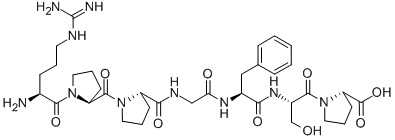23815-87-4
 23815-87-4 結(jié)構(gòu)式
23815-87-4 結(jié)構(gòu)式
基本信息
1-7-血管舒緩激肽
BRADYKININ (1-7)|舒緩激肽片段1-7
1-7-Bradykinin
BRADYKININ (1-7)
BRADYKININ 1-7 ACETATE
BRADYKININ FRAGMENT 1-7
ARG-PRO-PRO-GLY-PHE-SER-PRO
[Des-Phe8-des-Arg9]bradykinin
Arg-Pro-Pro-Gly-Phe-Ser-Pro-OH
des-phe(8)-des-arg(9)-bradykini
H-Arg-Pro-Pro-Gly-Phe-Ser-Pro-OH
物理化學(xué)性質(zhì)
| 報(bào)價(jià)日期 | 產(chǎn)品編號 | 產(chǎn)品名稱 | CAS號 | 包裝 | 價(jià)格 |
| 2025/02/08 | HY-P1484 | 舒緩激肽片段1-7 Bradykinin (1-7) | 23815-87-4 | 5mg | 400元 |
| 2025/02/08 | HY-P1484 | 舒緩激肽片段1-7 Bradykinin (1-7) | 23815-87-4 | 10mg | 640元 |
| 2025/02/08 | HY-P1484 | 舒緩激肽片段1-7 Bradykinin (1-7) | 23815-87-4 | 25 mg | 1350元 |
常見問題列表
The Bradykinin peptide system is a tissue-based system with potent cardiovascular and renal effects. To investigate the regulation of this system, a highly sensitive amino terminal-directed radioimmunoassay that, with high performance liquid chromatography, enables the measurement of Bradykinin-(1-7), Bradykinin-(1-8), and Bradykinin-(1-9), is developed. Together with a carboxy terminal-directed radioimmunoassay, Bradykinin peptides in rat kidney and blood are characterized. The predominant Bradykinin peptides in kidney are Bradykinin-(1-9) (~100 fmol/g wet weight of tissue) and Bradykinin-(1-7) (~70 fmol/g), with low levels of Bradykinin-(1-8) (~8 fmol/g) and Bradykinin-(4-9) (~12 fmol/g) detectable; Bradykinin-(2-9) and Bradykinin-(3-9) are below the limits of detection. In blood, the levels of Bradykinin-(1-9) are very low (~2 fmol/ml), and other Bradykinin peptides are below the limits ofdetection. Administration of the angiotensin converting enzyme (ACE) inhibitor Perindopril is associated with an approximate twofold increase in renal levels of Bradykinin-(1-8) and Bradykinin-(1-9) and a decrease in the Bradykinin-(1-7)/Bradykinin-(1-9) ratio. The amino terminal-directed radioimmunoassay is also applied to heart, aorta, brown adipose tissue, adrenal, lung, and brain. For these tissues, Bradykinin-(1-7) and Bradykinin-(1-9) are of similar abundance (16-340 fmol/g), with lower levels of Bradykinin-(1-8).